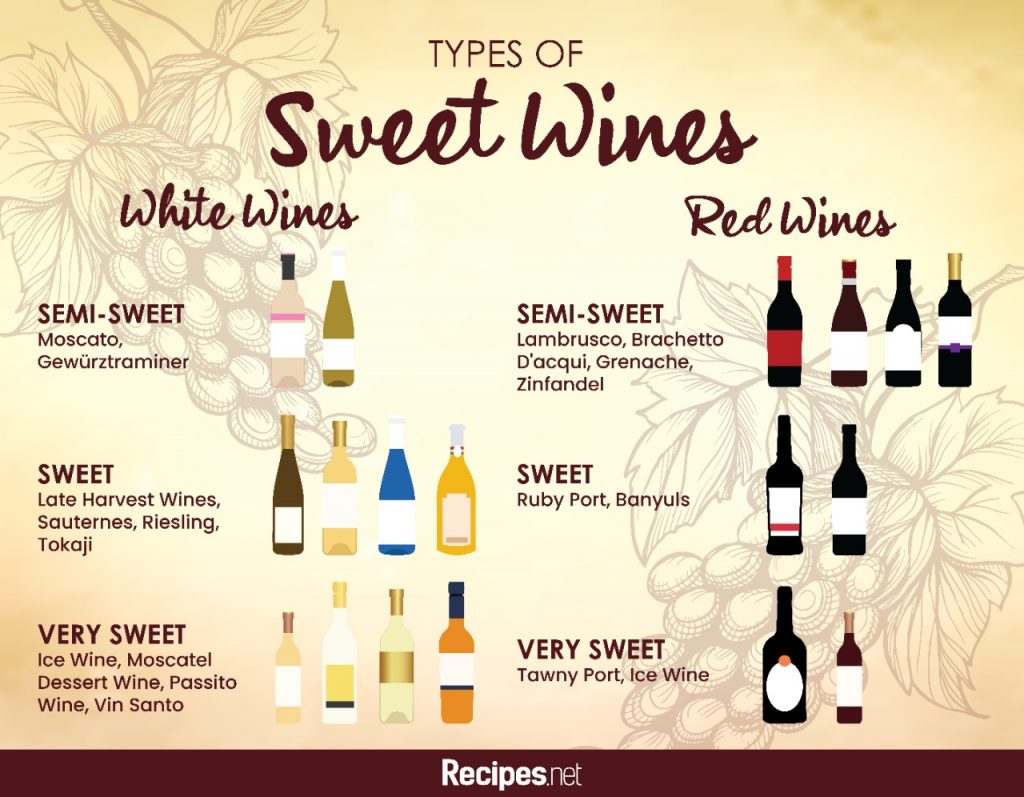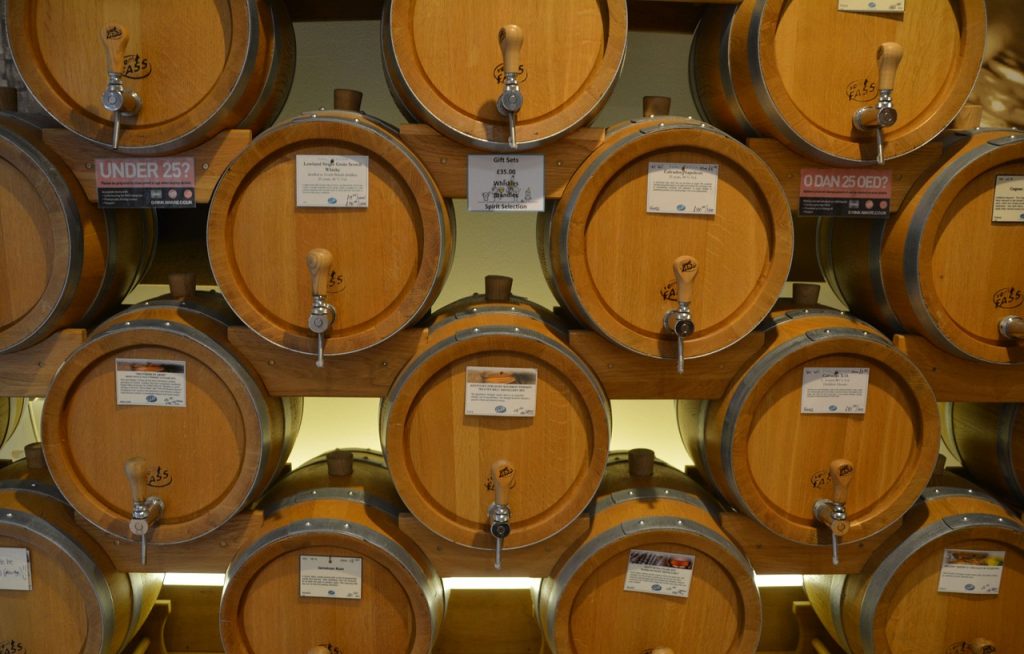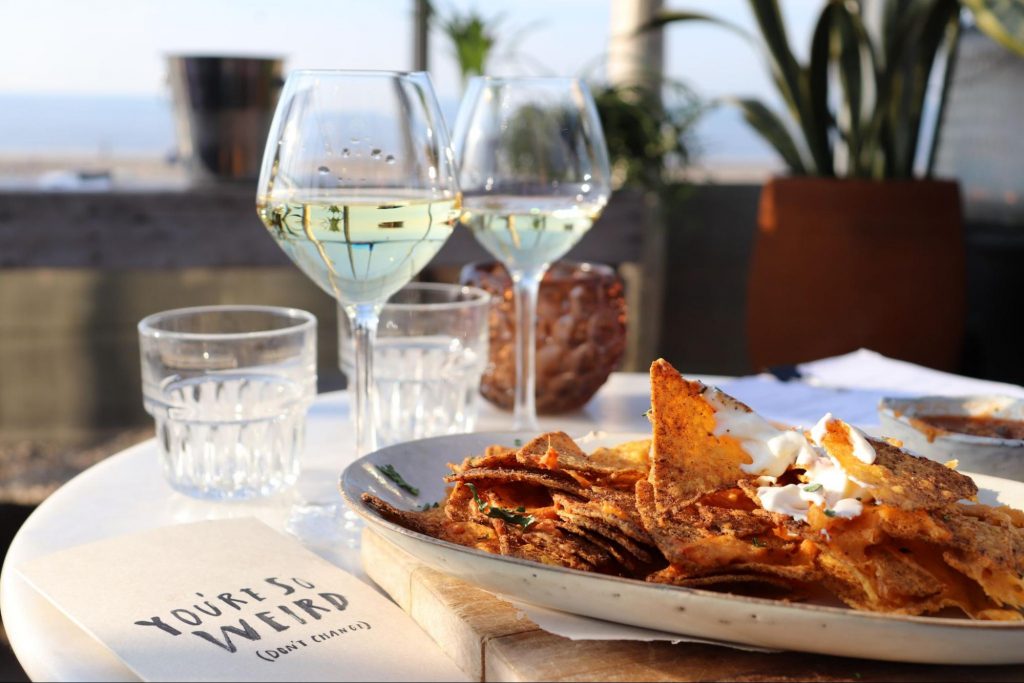
Most people consider sweet wines as the ideal gateway into the world of wine drinking. Their sugary, familiar taste primes our taste buds for the stronger and bolder types of wine to come. For this reason, they’re often mistaken for being not as grand as other alcoholic drinks. What not a lot of people know is that this type of wine was once the most coveted of all.
In addition to that, sweet wines undergo special processes to achieve their premium, elevated taste. Continue reading to discover more about this drink, as well as some of the best sweet wines for beginners and wine lovers to enjoy with roasted peanuts, almonds, fruits, and tasty charcuterie.
What Are Sweet Wines?

True to their collective name, sweet wines are in essence sweeter compared to other types due to several factors. To determine which wines are sweet, sommeliers or wine experts often consider aroma, amount of sugar, alcohol level, tannin content, and acidity present in a particular type of wine:
Aroma
Just like how our eyes eat first before our mouths, our noses “taste” wines first before our tongues. Catching a whiff from a glass of wine adds quite a lot to the drinking experience, so much so that wines that exude a sweet and floral aroma often give off the impression that they are just as sugary.
Residual Sugar
Much like in home brewing beer, sugar is a vital ingredient in winemaking. This particular one refers to the amount of leftover sugar after the wine is fully fermented. Wines with 45 grams per liter of residual sugar are generally considered sweet.
Alcohol
Sweet wines often have an alcohol by volume (ABV) of ten percent or lower, which is comparatively lower than other wines and alcoholic beverages.
Tannin
This is a drying and bitter natural substance that disperses into wines during the fermentation process from the grapes’ skin, stems, and seeds. Good sweet wines tend to have a lower amount of this compound.
Acidity
Most sweet wines have lower acidity because sourness counteracts the sweetness. More acidic wines tend to have a more dominant sourness and a drying feel overall.
Each kind of wine is bound to have different concentrations of these components. Wines with little to no sweetness are categorized as “dry wines.” On the other end of the spectrum, sweet wines can be classified anywhere from semi-sweet wines to very sweet. Refer to the sweet wine chart below for more information.
Wine Sweetness Chart

How is Sweet Wine Made?

The best sweet wines don’t achieve their prime state by accident. Instead, they require specific ingredients, such as very ripe grapes with more inherent sugar content. Another popular option among winemakers is to use sun-dried grapes or raisins with a more concentrated sweetness as opposed to fresh, plump grapes filled with water. The variety of grapes used to produce the wine can also be factored in, as some are naturally sweeter than others.
Special procedures can also be done. For instance, some winemakers stop fermentation early to preserve more residual sugar. Yeast can be filtered and extracted from the mixture to halt the fermentation process altogether. Freezing the grapes before fermentation while still attached to the vines is also done to produce a specific type of sweet wine called ice wine. Sweeteners like unfermented grape juice can be added after the fermentation to improve the taste of the wine.
18 Different Types of Sweet Wines For Beginners
In this section, we’ve put together a list of sweet wines categorized as either red or white and organized them from semi-sweet variants to very sweet ones. Here are some of the most popular sweet wines that even beginners are bound to enjoy:
Best Sweet White Wines for Beginners
Sweet wines are made with skinless grapes during fermentation. Because of this, the level of tannins found in the end-products is lower, making for wines with a sweeter finish.
Semi-Sweet Wines

Moscato
This is a popular Italian dessert wine made with grapes of the Muscat variety. Moscato d’Asti, made with Muscat Blanco (White Muscats) from the small city of Asti in Italy, is one of the best kinds of wine to try. It’s a Denominazione di origine controllata (DOCG) sparkling wine, which means that it’s of the highest quality. The Saracco brand produces a premium version of this type.
Sweet Moscato d’asti is a fruity wine that is notably delicate because of its light bubbles and notes of peaches, grapes, oranges, and lemons. This Moscato white wine is best paired with spicy food, nuts, crunchy veggies, soft cheeses like brie, strong-smelling cheeses like blue cheese, and cured meats from prosciutto to the ever luxurious Jamon Iberico.
READ ALSO: Iberico Pork: Why It’s So Expensive & All About The Cuts
Gewürztraminer
Also called Gerwurz, this wine’s name is German for “spice traminer” or “perfumed traminer” (traminer being a variety of white grapes grown in Germany and Alsace). Gewurztraminer is a semi-sweet white wine made with incredibly aromatic wine grapes of the same name.
Despite having a higher alcohol content (14 percent ABV) and a full-bodied flavor, its fruity scent gives off the illusion that it’s sweeter than it is. Its dominant scent and flavors are lychee, sweet rose, orange, and ginger. The lush and floral 2005 Gewürztraminer Selection de Grains Nobles Quintessence by Marcel Deiss is one of the leading vintages of this type.
Sweet Wines

Late Harvest Wines
This sweet wine is made with grapes that have been left longer than usual on their vines before being harvested for fermentation. This process gives the grapes a sweeter flavor. Late harvest wines have dominant notes of apricot, honey, and lemon, with an ABV of 14 percent. This wine goes great with citrus-flavored desserts, like this lemon meringue pie recipe, and foie gras. If you want to try it out, we highly recommend the golden and vibrantly fruity Grgich Hills 2016 Late Harvest Dessert Wine from Napa Valley.
Sauternes
This is one of the sweet white wine types that originate from France, specifically the Sauternes commune in Bordeaux. This wine is made with a combination of sauvignon blanc and thin-skinned Semillon grapes that have been allowed to rot.
Sauternes has notes of sweet apricot, caramel, and citrus. Serve it chilled with a delectable strawberry cheesecake and other fruit-based or custardy desserts. Foie gras and blue cheeses like the Roquefort also go exceptionally well with this wine. You can try the earthy and fruity Château Rieussec Sauternes (Premier Grand Cru Classé) for a premium experience.
Riesling
This aromatic wine is made with tart and highly fragrant Riesling grapes. Riesling wines can range from dry to sweet, and sweet varieties tend to have distinct hints of apricots, apples, and pears. Coupled with the natural acidity from the grape variety used in making this wine, these sweet notes work great with dishes packed with heat and spices. Asian, Cajun, and TexMex cuisine are popular pairing options. A bottle of this sweet white wine paired with pork roast will make for an unforgettable holiday dinner. The floral and incredibly aromatic Poet’s Leap Riesling is one of the best brands to try.
Tokaji
Tokaji, one of the oldest sweet wine types, hails from the historical Tokaj wine region in Hungary. Similar to sauternes, the grapes used for fermenting this wine have been intentionally affected by the botrytis fungus that causes the so-called “noble rot.” This concentrates and enhances the flavor of the grapes to produce a fruity wine with intense sweetness. Despite this, Tokaji isn’t too overpowering because it is also highly acidic, so the flavors are well-balanced. Serve a bottle of this exquisite wine slightly chilled, alongside pungent cheeses, foie gras, and chocolate desserts. Asian cuisine also works surprisingly well with this sweet fruity wine. Have a taste of this special Hungarian drink with a bottle of sweet and lush Dobogó 2007 Aszú 6 Puttonyos.
Very Sweet Wines

Ice Wine
Also known as eiswein in the regions of Germany and Austria, ice wines are made with grapes that have frozen on their vines during winter. The flavor in these frozen grapes is highly concentrated, making for a sweeter and more flavorful wine.
Like Tokaji, this wine is intensely sweet and incredibly acidic at the same time. This wine gives off a salvo of honey, citrus, peach, apricot, and tropical fruits like mango. Have a glass or two of this wine with fruit desserts, a slice of your favorite cheesecake or ice cream, or soft and pungent cheeses. We highly recommend the Inniskillin Vidal brand if you want to experience this dessert drink. They also offer sparkling and oak-barreled versions for more advanced palates.
Moscatel Dessert Wine
This wine is mostly made with grapes of the Moscatel de Alejandria or “Muscat of Alexandria” variety, either sundried (pasas) or fresh (dorado). The crushed fruit juice of this grape is thick and sugary, making fermentation slow. In addition to this, the fermentation process is stopped early, making for an incredibly sweet dessert wine with dominant notes of honeyed fruit, jasmine, and orange blossom.
Enjoy this wine with ice cream and desserts with just the right amount of sweetness. You wouldn’t want to have something that is too flavorful, as this sweet white wine is incredibly saccharine already. The luxurious 1955 vintage of José Maria da Fonseca Moscatel de Setúbal is a good choice for this type.
Passito Wine
This sweet Italian wine is made with sundried grapes. Passito wine is one of the best red dessert wines you can serve for your next get-together. Serve it at room temperature, with baked goods such as almond or shortbread cookies as well as sweet treats with a fruit base. You can try the Maculan Torcolato from Vincenza, Italy to experience the best of what passito wines have to offer.
Vin Santo
This wine hails from Tuscany, Italy. Vin Santo translates to “holy wine,” probably in relation to the holy communion. This is the sweetest white wine. It’s made with sundried grapes for a more concentrated sweetness. Overall, vin santo exudes dominant notes of apricot, figs, raisins, caramel, molasses, nuts, and tropical fruits. Serve this special wine with fruits, desserts, cheese, and nuts.
You can try the Isole e Olena Vin Santo del Chianti Classico brand for a dessert drink with dominant notes of caramel and dried fruit.
READ ALSO: Cooking with Beer: 10 Beer Recipes To Try
Best Sweet Red Wines for Beginners
It can be a bit of a challenge to figure out which red wines are sweet. Overall, red wines tend to be less sweet than white wines. This is because they are produced by fermenting grapes with their skin, and the bitter tannins on the grape skins make the wine drier. Find out the best sweet red wines for beginners below:
Semi-Sweet Wines

Lambrusco
This semi-sparkling sweet Italian wine is made with grapes of the same name. Lambrusco wine is widely distributed around the world and is relatively cheaper compared to most types of wine. It comes in two varieties: dry (secco) and semi-sweet (semisecco). The latter boasts notes of cherry, blackberry, and cream. In terms of food pairings, Lambrusco is the best semi-sweet red wine to pair with full-bodied, meaty flavors. Have it with your favorite hamburger recipe for a hearty meal. We highly recommend the Ceci Otello Lambrusco with dominant red and black fruit notes if you’re looking to try this type.
Brachetto D’acqui
This is a semi-sparkling sweet red wine from Piedmont, Italy classified as DOCG, so you can guarantee that it’s high quality. Brachetto D’acqui has low alcohol content at only 5.5 percent ABV. If you’re looking for the best wine for beginners, you might want to give this one a shot.
In terms of flavor, it is very fruity, with primary notes of strawberry and raspberry. For the best flavor experience, pair this superior wine with strawberry ice cream. For a premium experience, we suggest trying the Marenco Pineto Brachetto d’Acqui.
Grenache
Also called Garnacha, this semi-sweet red wine is made with Grenach grapes from multiple European countries as well as the U.S. Grenache red wine oozes notes of raspberry, strawberry, and black cherry with low to medium levels of acidity and tannin content. Hints of spices, particularly cinnamon, might be present. This wine is perfect for pairing with rich roast lamb, stews, and tuna. Borsao Bodegas Tres Picos Garnacha with prominent vanilla and black fruit notes is a popular brand to try, although this vintage is a bit drier.
Zinfandel
This is one of the most well-known sweet red wine types. Zinfandel is a dark red wine that is high in tannins, alcohol, and has medium levels of acidity. The primary flavor of this type is fruity, with notes of raspberry, blackberry, and plums. Earthy flavors from cinnamon, black pepper, and licorice might also shine through. This type is a good sweet red wine to serve alongside different types of meat dishes. Why not serve zinfandel for your next feast with maple roast turkey? The Seven Deadly Zins Old Vine Zinfandel by the Michael David Winery is a bold and slightly sweet version that you can try.
Sweet Wines

Ruby Port
This is a type of fortified sweet wine from the Douro Valley in Portugal. Ruby port is a sweet fruity red wine, with primary wine flavors of raspberry, blackberry, chocolate, and cinnamon. Enjoy it slightly cold on the rocks by itself or with desserts with similar flavors, specifically ones which are fruity or chocolate flavored. For a more savory pairing, flavored nuts and pork barbecue are good choices.
One of the best brands to try for this type is the W. & J. Graham’s Six Grapes Reserve Ruby Port N.V with primary notes of plum, chocolate, and cherry.
Banyuls
This sweet red wine originates from Roussillon, France. Banyuls wine is primarily made with very sweet Grenache grapes. Despite being incredibly sweet, it contains a high level of alcohol at 16 percent or more. Have this dessert wine by itself, or have it with fruit desserts, prunes, or baked goods drenched in sweet spices such as these cinnamon chips. The Cazes Les Clos de Paulilles Banyuls Rimage is a popular brand choice for this sweet red wine.
Very Sweet Wines

Tawny Port
This type of port wine is more orange than the ruby variant, and it has a sweeter flavor of caramel and nuts. Tawny ports aged for more than 30 years carry more complex nutty and earthy notes like graphite. Serve it cool with nut-flavored pastries and desserts like this hazelnut biscotti, as well as caramel treats. Want to know what this red wine has to offer? We suggest trying Taylor’s 10-Year-Old Tawny Port N.V., as it’s among the most raved brands.
Ice Wine
Similar to the white version, red ice wine is made with frozen grapes. It has a more pronounced fruity flavor like strawberry and a bit of heat that lingers on your palate. If you’re planning on pairing this with cheese, go for soft and creamy or pungent ones. Desserts like ice cream, cheesecake, and fruity baked goods should work well with this. Cap off your meal with a bottle of fruity Peller Estates Cabernet Franc Icewine for a memorable experience.
READ ALSO: 14 Types of Sweet Red Wine Perfect for Special Occasions
Discover Which Sweet Wines Satisfy Your Palate
Other factors like food pairings and your genetic makeup may affect how you perceive the sweetness in wines.
For example, some people are more sensitive to tannins, so they may experience a heightened bitterness and astringency in sweet wines. The taste of a specific type of dessert wine can change if you pair it with a salty dish as opposed to a sweet treat. Salt tends to highlight the taste of tannins, so wines would taste a bit drier alongside it.
At the end of the day, it all boils down to your personal preference. Feel free to try out different sweet wine and food pairings to see which ones you like.











